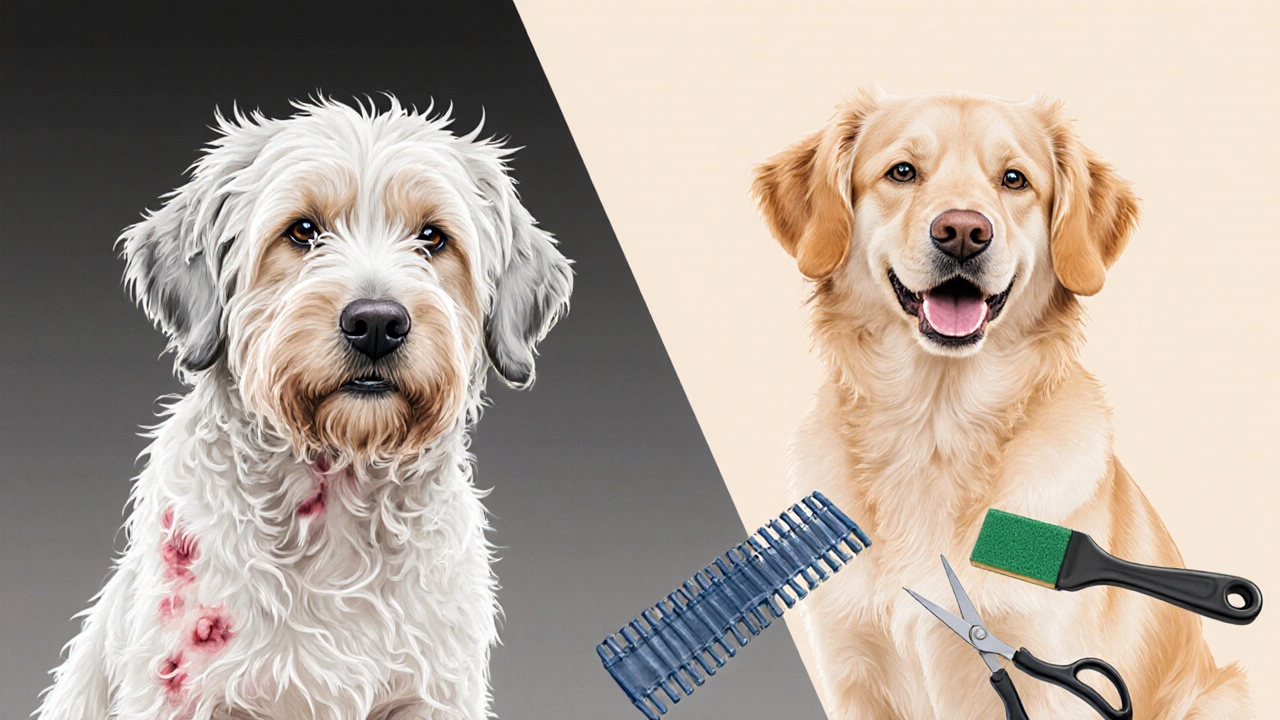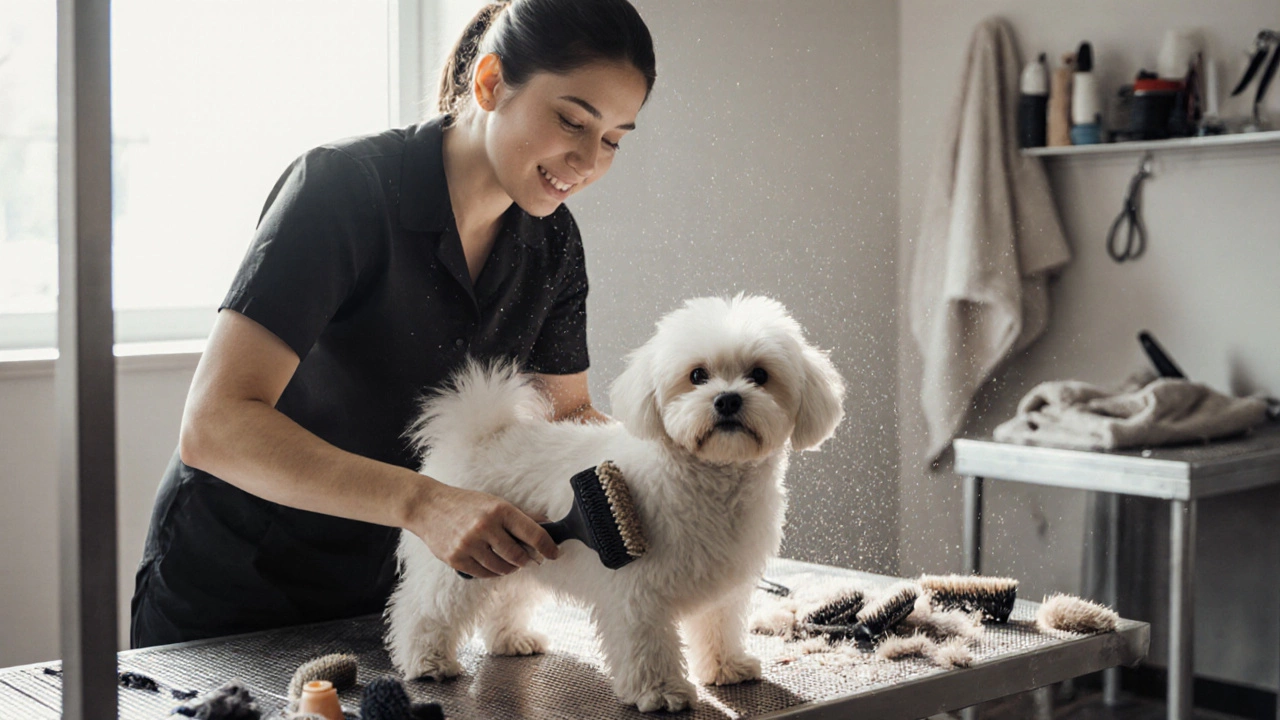Grooming Time Estimator
How long will your dog's grooming take?
Answer these questions to get your estimated grooming duration based on professional standards.
Ever watched a dog groomer work and wondered why it takes three to four hours for a simple haircut? You might think, It’s just hair. How hard can it be? But if you’ve ever tried to brush out a matted Poodle or bathe a wriggly Golden Retriever at home, you know it’s not that simple. Professional dog grooming isn’t a quick trim-it’s a full-body health check wrapped in patience, skill, and precision.
It’s Not Just a Haircut
Most people assume dog grooming means clipping nails and giving a bath. But a full professional session includes way more: brushing out tangles, bathing with medicated or conditioning shampoos, drying completely, trimming fur around sensitive areas, cleaning ears, expressing anal glands (if needed), and styling based on breed standards. Each step is done slowly and safely. Rushing any part can hurt the dog or cause long-term damage.Take drying, for example. A wet dog left with damp fur under its coat can develop hot spots, fungal infections, or skin irritation. Professional groomers use high-velocity dryers and hand-held blow dryers to make sure every inch of fur is dry-especially under the armpits, behind the ears, and between the paw pads. That alone can take 45 minutes to an hour for a medium-to-large dog with thick undercoat.
Breed-Specific Needs Change Everything
Not all dogs take the same time to groom. A Chihuahua with short hair might be done in under an hour. But a Shih Tzu with a long, silky coat? That’s a different story. Breeds like Poodles, Bichon Frises, and Maltese have hair that grows continuously-like human hair-and needs regular trimming to avoid mats. A full breed-standard trim for a Poodle isn’t just about looking cute. It’s functional. The clipped areas protect joints and organs, while the fluffy parts keep the dog warm and dry.Double-coated breeds like Huskies, German Shepherds, and Golden Retrievers shed heavily twice a year. During these seasons, grooming isn’t optional-it’s essential. A groomer spends 30-45 minutes just de-shedding with an undercoat rake before even starting the bath. Skipping this step means clumps of fur will stay trapped under the topcoat, leading to skin infections and discomfort.
Behavior and Safety Matter More Than Speed
A dog that’s anxious, scared, or has never been groomed before doesn’t just sit still. They wiggle, jump, turn, bark, or freeze up. Groomers have to work around these behaviors without forcing the dog. That means taking breaks, offering treats, speaking calmly, and using gentle restraint techniques. Some dogs need multiple sessions to build trust. One groomer in Wellington told me about a rescue terrier who took six visits before he’d let anyone near his paws. That’s not inefficiency-that’s ethics.Even well-behaved dogs can’t be rushed. One wrong snip near the ear or eyelid can cause injury. Groomers use blunt-tipped scissors for sensitive zones and electric clippers with guards to avoid burns or cuts. They check for lumps, ticks, rashes, or sores during every session. If they find something unusual, they’ll pause and alert the owner. That’s part of the job.
The Bathing Process Is More Complex Than You Think
You might think, Just put the dog in water, lather, rinse, done. But professional baths are multi-step. First, they pre-brush to remove loose fur and tangles-bathing a matted dog makes mats worse. Then they use a dog-specific shampoo, sometimes medicated for allergies or fleas. The shampoo sits for 5-10 minutes to work properly. After rinsing, they apply a conditioner, leave it on, then rinse again. Some dogs need a second wash if they’re muddy or have strong odors.Then comes the drying. No towel-drying here. High-velocity dryers blast air to remove bulk water, followed by a hand dryer to fluff and smooth the coat. This ensures no moisture is trapped. Wet skin breeds bacteria. For a large dog with thick fur, this process can take up to 70 minutes.

Nail Trims, Ear Cleaning, and Anal Glands
Nails aren’t just clipped-they’re filed smooth to prevent cracking or snagging. Overgrown nails can cause pain, affect gait, and even lead to joint problems. Groomers check each nail for signs of infection or ingrowth.Ear cleaning is critical for floppy-eared breeds like Cocker Spaniels or Basset Hounds. They use a vet-approved cleaner and cotton balls to gently wipe the outer canal. No Q-tips-those can push debris deeper. If there’s wax buildup or odor, they’ll note it and recommend a vet visit.
Expressing anal glands is not always part of grooming, but many groomers do it as a routine. If a dog’s glands are full, they can cause discomfort, scooting, or infection. Groomers are trained to do this safely. If they can’t express them, they’ll tell you to see a vet. This step alone adds 10-15 minutes to the session.
Why You Can’t Skip the Brushing
Brushing isn’t a quick pre-bath task. It’s the foundation. A single matted coat can take 20-40 minutes to work out, depending on severity. You can’t just cut mats out-doing so risks cutting the skin. Groomers use dematting tools, combs, and patience to gently separate the tangles. Some mats are so tight they need to be shaved off with clippers, which leaves bald patches and takes weeks to grow back.At-home owners often skip brushing because it’s time-consuming. But that’s why their dogs end up needing professional help. A dog brushed daily takes half the time to groom. One brushed weekly? That’s a two-hour job. One brushed once a month? That’s a three-hour emergency rescue.
What Happens When You Cut Corners
If you go to a cheap groomer who rushes through, you might get a dog that looks fine on the surface-but underneath, there’s pain. Mats hidden under the coat. Skin infections from trapped moisture. Overgrown nails causing limping. Ear infections going unnoticed. These problems show up later, often at the vet, and cost more than a proper grooming session.One client in Wellington brought her Shih Tzu in after a $30 groom at a mall kiosk. The dog had a severe skin infection under the fur, a broken nail, and one ear was swollen. The groomer hadn’t checked anything. The vet bill? $420. That’s the hidden cost of skipping proper care.

How Often Should You Groom Your Dog?
For most dogs with medium-to-long hair, every 4 to 6 weeks is ideal. Short-haired breeds can go 8-12 weeks. But daily brushing at home cuts grooming time in half and keeps your dog healthier. A quick 5-minute brush three times a week prevents mats, reduces shedding, and lets you catch problems early.And don’t forget: grooming isn’t just about looks. It’s about comfort, hygiene, and early detection. A groomer is often the first to spot a new lump, a tick, or a change in skin texture. That’s why a 3-4 hour session isn’t excessive-it’s necessary.
What You Can Do at Home
You don’t need to do everything yourself, but you can help. Brush your dog regularly. Clean their ears weekly. Trim their nails if you’re comfortable. Bathe them every 4-6 weeks with a dog-safe shampoo. This reduces the time and stress at the salon. Your dog will thank you-and so will your wallet.Why does my dog need 4 hours of grooming when I can do it in 30 minutes?
If you’re doing a quick bath and trim at home, you’re probably skipping key steps: thorough brushing, complete drying, ear cleaning, anal gland checks, and nail filing. Professional groomers spend time ensuring the dog is safe, clean, and healthy-not just tidy. What looks like a long session is actually thorough care.
Can I shorten the grooming time by bringing my dog in less often?
No. If you wait longer between visits, mats and dirt build up, making each session longer and harder. A dog groomed every 8 weeks takes 50% more time than one groomed every 4 weeks. Consistency saves time and stress-for you and your dog.
Is it normal for a groomer to take breaks during the session?
Yes. Especially with nervous, elderly, or large dogs. Groomers give breaks to let the dog relax, drink water, or calm down. Rushing can lead to accidents or injuries. A calm dog is a safe dog-and that’s the goal.
Do all groomers express anal glands?
No. It’s not required, and some groomers won’t do it unless trained or permitted. Many will check for signs of fullness and tell you if your dog needs a vet. It’s a medical task, and not all groomers are legally allowed to perform it.
Why do groomers use so many tools?
Each tool has a purpose: slicker brushes for undercoat, pin brushes for long hair, dematting tools for tangles, clippers with different blade sizes for specific cuts, and high-velocity dryers for deep drying. Using the right tool prevents injury and ensures quality. It’s not overkill-it’s precision.
Final Thought: It’s Worth It
Three to four hours sounds like a lot-but think of it this way: that’s the time a groomer spends making sure your dog isn’t itchy, infected, or in pain. It’s the difference between a dog who loves being touched and one who flinches at the brush. It’s the difference between a healthy coat and a skin disease. And honestly? It’s cheaper than a vet visit caused by neglect.If you’ve ever wondered why professional grooming costs what it does, now you know. It’s not just a haircut. It’s preventive healthcare-with scissors, dryers, and a whole lot of patience.
